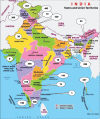Hand, Foot and Mouth Disease: A Single Centre Retrospective Study of 403 New Cases and Brief Review of Relevant Indian Literature to Understand Clinical, Epidemiological, and Virological Attributes of a Long-Lasting Indian Epidemic
- PMID: 36226004
- PMCID: PMC9549533
- DOI: 10.4103/idoj.idoj_701_21
Hand, Foot and Mouth Disease: A Single Centre Retrospective Study of 403 New Cases and Brief Review of Relevant Indian Literature to Understand Clinical, Epidemiological, and Virological Attributes of a Long-Lasting Indian Epidemic
Abstract
Background: There have been sporadic and periodic large-scale epidemics of hand, foot, and mouth disease (HFMD) with cases at risk for significant morbidity and mortality particularly in Southeast Asia since 1997 and in India since early 2003.
Method: We retrospectively studied 403 cases recorded from 2009 to 2019 and reviewed relevant Indian literature published between 2004 and 2019 to understand clinical, epidemiological, and virological attributes of this long-lasting Indian epidemic.
Result: There were 96.8% children and adolescents (M:F 1.6:1) aged 2 months to 18 years and 84% were aged <5 years. Adult family contacts comprised 3.2%. Only 12 sporadic cases occurred during 2009-2011 followed by increased number from 2012 to 2015 peaking with 30.8% cases in 2013 and declining slowly until the year 2019 with small resurge in 2018. The major peaks occurred during summers with small peaks in autumns. Literature review showed 3332 cases presenting between 2004 and 2019 across Indian states with similar epidemiological trends whereas serotyping identified Coxsackievirus A16 (CV A16) in 83%, Coxsackievirus A6 (CV A6) in 17%, Enterovirus 71 in 4.1%, and multiple strains in 11.7% samples, respectively.
Conclusion: The overall features of this long-lasting HFMD epidemic; affecting children aged <5 years more often than adults, none or minimum neurological or pulmonary complications in few patients, peaks occurring during summer and autumn months, and identity of the pathogenic virus coincide with global trends. However, the continuous spread of the disease across the country appears in sync with pre-epidemic periods of China and Taiwan. It calls for a continuous surveillance and making HFMD a notifiable disease in India.
Keywords: Coxsackievirus A16; HFMD; India; Southeast Asia; coxsackievirus A6; epidemic; human enterovirus 71; onychomadesis; viral infection.
Copyright: © 2022 Indian Dermatology Online Journal.
Conflict of interest statement
There are no conflicts of interest.
Figures







References
-
- Ogi M, Yano Y, Chikahira M, Takai D, Oshibe T, Arashiro T, et al. Characterization of genome sequences and clinical features of coxsackievirus A6 strains collected in Hyogo, Japan in 1999–2013. J Med Virol. 2017;89:1395–403. - PubMed
Publication types
LinkOut - more resources
Full Text Sources

